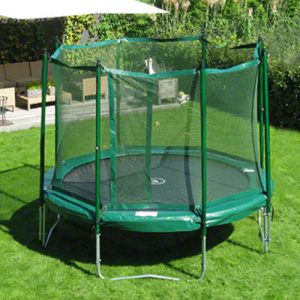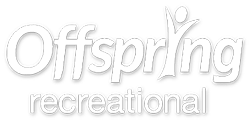Jumpfree has the absolutely best enclosure on the market and attractively priced. If it is going to promote “safety”, it should be a device that has a long life and well designed to accomplish its purpose. A lot of really bad merchandise is out there under the name “trampoline” and “trampoline enclosure”.
Asian labor in manufacturing trampolines constitutes a very small portion of the cost of the trampoline. Therefore, Asian trampoline manufacturers can only reduce prices appreciably by:
1. Reducing the amount of material used
2. Reducing the quality of the material used
Because trampolines are heavily used by most buyers and because they tend to be used for a large number of years, compromises in quality vastly affects the useful life of the trampoline. Using sub standard materials that are manufactured in a poor quality controlled environment could create problems that affect the life, usability, and safety of the trampoline..
For example, use of substandard material for the frame safety pads means that the pads will wear out much sooner than the rest of the trampoline. Once the pad fails, then jumpers will be exposed to the dangers of an unpadded frame/springs until the pad is replaced, if it ever is.
Use of steel tubing that is too light to be successfully welded will lead to premature frame failure and potential danger to the jumper if the frame fails.
Poor netting material on the enclosures means the enclosure will soon be without a net eliminating the safety benefits of the enclosure.
Frames ;
The optimum frame design is the eight piece top rail trampoline with 8 legs of the style pioneered by Jumpking Trampolines with welded leg sockets. Any other design configuration is to cover up material defects or to fit the boxed units into shorter boxes to meet unique retailer shelve specifications (ex: Wal-Mart needs 48-inch boxes for their modular shelving scheme).
N.B. In 2005/2006 the Jumpking Trampoline company sold their name to a Chinese manufacturer.
Jumpfree Frames:
Jumpfree copied the basic Jumpking premium trampoline design (some of these are now over 15 years old) and improved on them with subtle design improvements.
Key features:
“W” Legs – These units are the most stable. Other designs are subject to instability on irregular ground surfaces.
Steel Specifications – few Chinese manufacturers use steel tubing built to US specifications, so you never know from the tubing thickness what you are getting. Jumpfree uses steel tubing from Taiwan which manufactures its tubing to US specifications.
Galvanized Tubing – see “steel specifications” above. Jumpfree tubing is properly galvanized. Much of what comes from China is prone to premature rusting.
Welded Leg Sockets – Use of poor of light weight tubing that is hard to weld properly has led to the use of substitute designs. “T” sockets are one such substitute, but the for the manufacturer to offset the addition cost of the “T” sockets, he has to reduce the weight of the top rails which tend to bend upon contact with a jumper.
Use of lighter gage tubing and smaller diameter tubing are two of the quickest routes used by Asian manufacturers to reduce the price of their trampoline. Steel purchased is by weight, so each less pound of steel used produces a cost reduction of approximately $0.50. If the steel tubing is sub standard, the reduction will be even more.
One way manufacturers use to reduce the weight of steel tubing required is to build trampolines with more top rails thereby reducing the spans and the weight of tubing required. Unfortunately, this route leads to weld failures from use of the lighter weight tubing.
These designs also create more parts and are more difficult to assemble. These frames tend to twist under stress or heavy use.
Comments:
Avoid 16 piece top rail designs.
Avoid trampolines with leg configuration other than the Jumpking “W”.
Avoid trampolines without standard welded leg socket designs.
Springs
To carry jumpers of all weights with reasonable safely, 14 foot trampolines should have a minimum of 96 each good quality 215 mm (8.5-inch) long springs. Springs steel is also sold by weight, so any reduction in spring count, spring length, or spring wire diameter will reduce the cost of the springs, and the quality of the trampoline. The weight of 96 standard 8.5″ mm springs is approximately 51 kilogram, so significant savings can be made by providing reduced spring configurations.
Additionally, Chinese made springs have been consistently of poor quality both as to tension strength and galvanized finish. Weak tension, which furnish poor jumping characteristics, and premature rusting are common complaints.
Comments:
The most frequent spring substitutions for 14-foot trampolines are 80, 84, or 88 each 7-inch long springs. Some models use 4.5″-5.5″ springs.
If 7-inch springs are used on a 14 or 15-foot trampolines, one should never go below 96 in total number.
The Jumpfree springs are made in its plant and are made to former Jumpking specifications and quality.
Jumpfree affixes plastic covers on the ends of the sharp spring hooks to protect the jumper from these sharp ends.
Frame Safety Pads:
Frame pads protect jumpers from a variety of injuries that can occur when the jumper encounters the top rail. A frame safety pad with a sturdy cover, adequate foam lining, wide enough to cover the top rail and the springs, and a good attachment system is an absolute requirement for any trampoline.
The pad consists of a foam center covered by a flexible cover and suitable attachments to secure it to the frame. A “skirt” is sewn around the perimeter to enhance the appearance of the trampoline. Pads offer fantastic opportunity for the manufacturer to save money both with the opportunity to substitute poor materials with short exterior life for good materials that can give long life under extreme weather and use conditions. What looks good does not necessarily last long. Furthermore, good pad materials are relatively more expensive than poor materials.
A good quality trampoline will be furnished with pads made of high quality closed cell foam, heavy coated top cover, and a suitable bottom material. Shorter springs means the pad can be narrower; therefore, compromising a spring specification also reduces the cost of the pad to cover the shorter spring.
Comments:
Foam thickness must be at least .75 inches.
Pads should fully cover the springs (most do now).
Bottom fabrics should be strong enough to resist the wear of friction with the springs
Pads not fully sewn or heat sealed closed should be avoided, that is, those that require the customer to assemble the foam into the cover.
Jumpfree uses only heavy duty coated vinyl on its pads.
The inner seams are heat sealed.
Heavy under materials are used, the same as the top vinyl on the higher end pads.
Excellent attachments are used to keep the pad in place.
The pad skirts are long for attractive appearance
Jumping Surface (“bed”):
Traditionally, polypropylene bed material has been available from only two or three manufacturers and has been of about the same quality. The standard polypropylene trampoline bed fabric allows the bed to “breath” air through it with each jump. The other options for a manufacturer to save costs on beds is the reduced number of spring hooks (“V” rings), the quality of the “V” rings, the number of lines of sewing used to connect the “V” rings, and the quality of the thread, which should be heavy and U/V treated. The manufacturers use all of these means to take cost out of the beds that result in shorter bed life.
Comments:
Only the most experienced observer can detect most of these bed differences, so the buyer should beware, especially on very low cost units.
Jumpfree furnishes unique “V”-rings that are plastic covered to reduce rusting. The beds are also sewn with heavy UV resistant thread and the edge seams have a minimum of 6 rows.
Safety Enclosures:
Safety enclosures were designed to keep the jumper from impacting the trampoline frame and to prevent the jumper from jumping or falling off of the trampoline. Enclosures are increasingly becoming standard trampolines accessories and increasingly sold as a package with the trampoline.
Because they are increasing used, enclosures are another great opportunity for the manufacturer to substitute sub standard materials and designs at reduced costs. For example, a four leg trampoline should have its enclosure net supported by 8 uprights, but some manufacturers reduce their costs on the uprights in half by only providing four support poles.
Jumpfree enclosures have these features, most of which are unique:
Eight longer straight pole design; 2 U-bolt brackets per pole.
Foam on poles covered by protective vinyl sleeves.
Heat sealed 2-inch vinyl top and bottom net perimeter seams.
Attachments are threaded through reinforced clear nylon guides built the net seams.
Very easy to assemble.
Trampoline Cost and Popularity
In purchasing a trampoline, parents must be aware that round trampolines have become a commodity item for many of the discount retailers. They often use the popularity of trampolines as a traffic generating “sale” item. 14-foot diameter trampolines with enclosures can be purchased from some American retailers in the range of $200 to $230. Low quality units will have fewer and shorter springs and should be avoided.
Only high quality, heavy duty 14 diameter trampolines or large rectangular trampolines should be purchased. To provide a good, soft bounce and to support heavier jumpers, good trampolines are equipped with at least 96 each 8 1/2 – inch long springs.
It is recommended each trampoline be purchased with a well built safety enclosure to go with it. Enclosures are designed to eliminate a jumper falling off of the trampoline onto the ground or in some designs to keep hands and feet out of the springs.
This lowering of quality and price that is basically driven by the discount chains has caused the large American trampoline companies to cease manufacturing trampolines. As a result of this price competition among the large retailers and the resulting spiraling down of trampoline quality, very few high quality, heavy duty trampolines are being manufactured today. These are almost exclusively available only from Internet trampoline specialists, who have contracted to have trampolines and enclosures made to their specifications or who purchase trampolines built to the higher European standards. These units will cost in the range of $730 – $1000 (depending on size) for a trampoline and a safety enclosure. The frames for these units normally have a useful life of 5-10 years, or more. You should consider ordering an optional ladder for easier entry on to the trampoline and into the enclosure.


